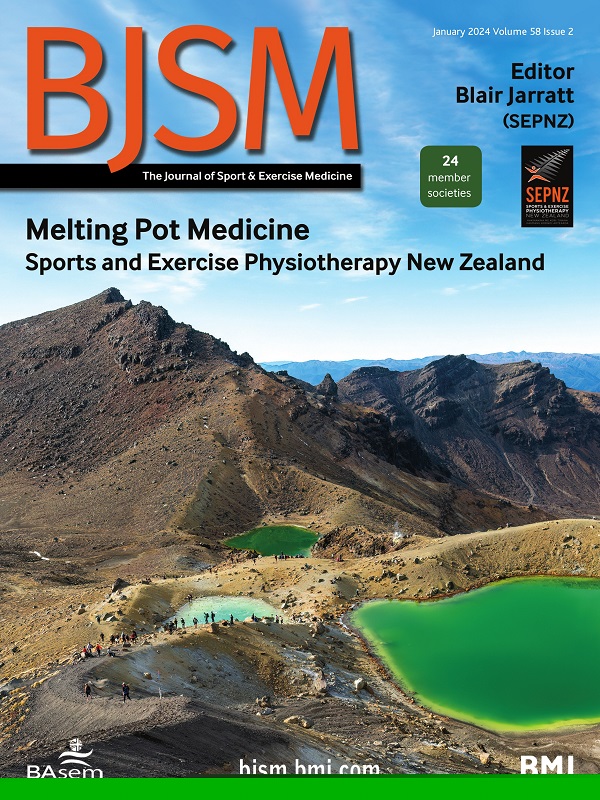精英残疾人运动中的健康促进:弥合知识差距和解决个人需求——对安全和健康残疾人运动(SHAPE)干预的定性评估
IF 16.2
1区 医学
Q1 SPORT SCIENCES
引用次数: 0
摘要
目的定性探讨残障运动员、教练员和利益相关者对健康促进干预“安全健康残障运动”(Safe and Healthy Para sport, SHAPE)的实施、使用和效果的认知。第二个目的是探讨与会者对如何进一步发展残疾人运动的安全和健康的看法。方法作为过程评估的一部分,本定性描述性研究采用了专题分析方法。共有来自瑞典和南非的18名参加者(运动员、教练和工作人员)参加了三个焦点小组。焦点小组产生了三个主题:“如何在实施和使用中接触到每一位残疾人运动员”,“积极的运动员成长和支持”,以及“可持续残疾人运动的机会”。与会者认为,SHAPE干预措施对最终用户很友好,而且很难在其他地方找到残疾人运动员的健康促进材料。运动员利用这些健康信息从受伤中恢复过来,他们对心理健康状况的认识有所提高。运动员也发现需要更个性化的内容,但一些运动员不知道健康平台。有人建议,同伴支持可以更好地促进残疾人运动中的健康。每周的运动员健康监测在运动员之间和体育组织内部培养了一种问责感,但与会者仍然认为,残疾人运动大多忽视了医疗评估,并表示有必要加强医疗和经济支持结构。结论健康促进可以提高残疾人运动员的健康水平和幸福感。然而,接触到单个运动员是具有挑战性的,这表明应该在残疾人运动的社会生态模式的每一层实施健康促进。如有合理要求,可提供资料。本文章由计算机程序翻译,如有差异,请以英文原文为准。
Health promotion in elite Para sport: bridging knowledge gaps and addressing individual needs—a qualitative evaluation of the Safe and Healthy Para sport (SHAPE) intervention
Objective To qualitatively explore the perceptions of Para athletes, coaches and stakeholders of the implementation, use and effects of the health promotion intervention ‘Safe and Healthy Para sport’ (SHAPE). A secondary aim was to explore participants’ perceptions of how safety and health in Para sport could be further developed. Methods As part of a process evaluation, this qualitative, descriptive study applied a thematic analysis approach. In total, 18 participants (athletes, coaches and staff) from Sweden and South Africa participated in three focus groups. Results Three themes were generated from the focus groups: ‘how to reach every Para athlete in implementation and use’, ‘proactive athlete growth and support’, and ‘opportunities for sustainable Para sport’. Participants perceived that the SHAPE intervention was end-user friendly and that it was difficult to find health promotion material for Para athletes elsewhere. Athletes had used the health information to recover from injuries, and their awareness of mental health conditions had increased. Athletes also identified a need for more individualised content, but some athletes were not aware of the health platform. It was suggested that health promotion in Para sport could be better facilitated by peer support. The weekly athlete health monitoring fostered a sense of accountability both among athletes and within the sports organisation, but participants still perceived that medical evaluations are mostly neglected in Para sport and voiced a need to strengthen medical and economic support structures. Conclusion Health promotion can be used to improve health and well-being among Para athletes. However, it was challenging to reach out to the individual athlete, suggesting that health promotion should be implemented in each layer of the socioecological model within Para sport. Data are available upon reasonable request.
求助全文
通过发布文献求助,成功后即可免费获取论文全文。
去求助
来源期刊
CiteScore
27.10
自引率
4.90%
发文量
217
审稿时长
3-8 weeks
期刊介绍:
The British Journal of Sports Medicine (BJSM) is a dynamic platform that presents groundbreaking research, thought-provoking reviews, and meaningful discussions on sport and exercise medicine. Our focus encompasses various clinically-relevant aspects such as physiotherapy, physical therapy, and rehabilitation. With an aim to foster innovation, education, and knowledge translation, we strive to bridge the gap between research and practical implementation in the field. Our multi-media approach, including web, print, video, and audio resources, along with our active presence on social media, connects a global community of healthcare professionals dedicated to treating active individuals.

 求助内容:
求助内容: 应助结果提醒方式:
应助结果提醒方式:


